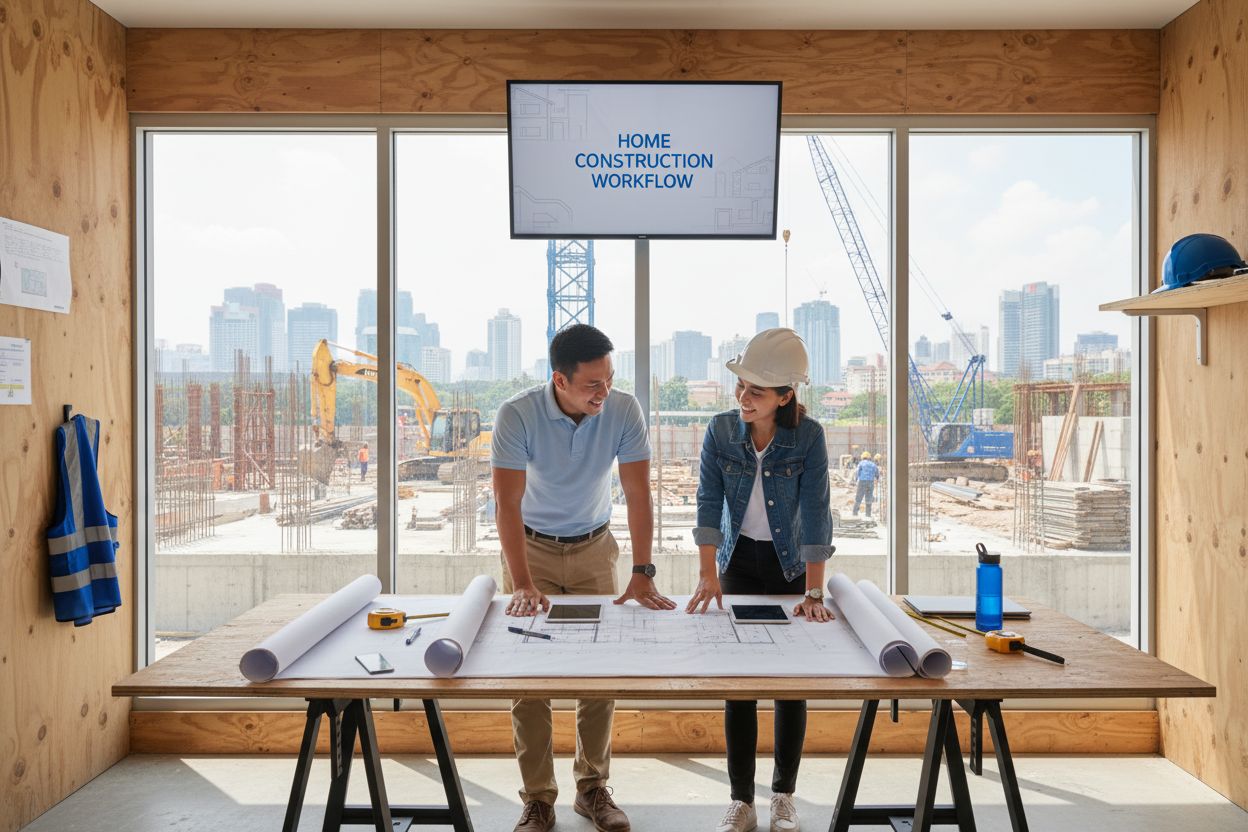Building a home is much more than bricks and blueprints. It is a sequence of choices that can change your budget, your timeline, and even your peace of mind. Most people expect the chaos of delays and surprise costs, but the truth is a well-structured home construction workflow can actually cut project delays by up to 30% and make overspending far less likely. That flips the typical building nightmare right on its head.
Table of Contents
- What Is Home Construction Workflow?
- Why Understanding Home Construction Workflow Matters
- The Key Phases Of Home Construction Workflow
- How Home Construction Workflow Enhances Project Management
- Real-World Applications Of Home Construction Workflow
Quick Summary
| Takeaway | Explanation |
|---|---|
| Understand the construction workflow phases | Familiarity with workflow phases enhances project management and improves outcomes significantly. |
| Implement proactive risk management strategies | Early identification of potential challenges allows stakeholders to mitigate risks effectively and manage budgets better. |
| Maintain rigorous quality standards | Ensure that each construction phase meets local regulations to avoid costly future repairs and ensure structural integrity. |
| Establish clear communication channels | A well-documented workflow fosters transparency among stakeholders, minimising misunderstandings and easing collaboration. |
| Allocate resources strategically | Effective resource management optimises material use and labour scheduling, reducing delays and costs throughout the project. |
What is Home Construction Workflow?
A home construction workflow represents a comprehensive systematic approach that guides the entire process of building a residential property from initial concept to final completion. This strategic framework outlines the sequential stages, tasks, resources, and interactions required to transform an empty plot of land into a fully functional living space.
Understanding the Core Concept
At its fundamental level, a home construction workflow is more than just a series of steps. It is a meticulously planned roadmap that coordinates multiple professionals, complex activities, regulatory requirements, and technical processes. The workflow serves as a critical blueprint that ensures efficiency, quality control, and successful project delivery.
The workflow typically encompasses several interconnected phases that progress logically from preliminary planning to final handover. These phases are not random or arbitrary but carefully designed to minimise risks, manage resources effectively, and maintain high standards of construction quality.
Key Components of Construction Workflow
A robust home construction workflow generally includes several fundamental components that work in synchronised harmony:
- Project Initiation: Defining project scope, objectives, and preliminary design concepts
- Architectural Planning: Creating detailed structural designs and architectural blueprints
- Regulatory Compliance: Obtaining necessary permits and ensuring adherence to local building regulations
- Resource Allocation: Selecting materials, equipment, and human resources
- Construction Execution: Implementing design plans through systematic building stages
- Quality Assurance: Conducting regular inspections and maintaining construction standards
According to Construction Industry Institute, effective workflow management can reduce project delays by up to 30% and minimize unexpected budget overruns. The systematic approach allows for continuous monitoring, predictable progress tracking, and proactive problem resolution throughout the construction process.
By understanding and implementing a structured home construction workflow, property owners and developers can significantly enhance project predictability, control costs, and ensure the successful realisation of their residential building objectives.
Why Understanding Home Construction Workflow Matters
Understanding the home construction workflow is paramount for anyone embarking on a residential building project. It is not merely an administrative exercise but a strategic approach that can profoundly impact project success, financial outcomes, and overall building quality.
Risk Mitigation and Financial Control
A comprehensive workflow understanding directly translates to financial risk management. Without a structured approach, construction projects can quickly spiral into costly disasters. Unexpected complications, poor planning, and inefficient resource allocation can lead to significant budget overruns and project delays.
Professional contractors and project managers emphasise that a well-defined workflow helps predict potential challenges before they become expensive problems. This proactive approach allows stakeholders to allocate resources more effectively, anticipate potential bottlenecks, and develop contingency strategies.
Ensuring Quality and Regulatory Compliance
Construction workflows are not just about efficiency but also about maintaining rigorous quality standards and adhering to complex regulatory requirements. Each stage of the workflow includes specific quality checkpoints and compliance verification processes.
Key benefits of understanding the workflow include:
- Identifying potential structural and design issues early
- Ensuring all construction meets local building codes
- Maintaining consistent quality across different project stages
- Reducing the likelihood of future repair or modification expenses
According to McKinsey Global Institute, systematic workflow management can improve project productivity by up to 15% and reduce overall construction costs.
Stakeholder Communication and Transparency
A transparent and well-documented home construction workflow serves as a critical communication tool. It provides clear expectations for all parties involved, from architects and contractors to property owners. Read our guide on successful home construction planning to understand how effective communication can streamline your building process.
By comprehensively understanding each workflow stage, stakeholders can:
- Establish clear communication channels
- Set realistic project milestones
- Manage expectations effectively
- Resolve potential conflicts proactively
In essence, mastering the home construction workflow is not just a technical requirement but a strategic approach that ensures smoother, more predictable, and ultimately more successful residential building projects.
The Key Phases of Home Construction Workflow
The home construction workflow is a meticulously structured process comprising distinct phases that transform architectural vision into physical reality. Each phase represents a critical stage with specific objectives, technical requirements, and interdependent activities that collectively ensure successful project completion.
Pre-Construction Planning Phase
The pre-construction phase is the foundational stage where comprehensive project groundwork occurs. This critical period involves detailed strategic planning that sets the trajectory for the entire construction process. Key activities during this phase include site assessment, geological surveys, architectural design development, budget estimation, and securing necessary regulatory approvals.
Critical components of pre-construction planning encompass:
- Conducting comprehensive site evaluations
- Developing initial architectural and engineering designs
- Obtaining municipal building permits
- Establishing precise project budgets and timelines
- Selecting appropriate construction materials and technologies
Construction Execution Phase
The construction execution phase represents the active building stage where theoretical plans transition into tangible structures. This complex phase involves systematic implementation of architectural blueprints through coordinated professional efforts. Check out our comprehensive guide on building your dream home to understand the nuanced details of this crucial stage.
According to National Association of Home Builders, the construction execution typically involves multiple sequential and parallel processes:
- Foundation and structural framework installation
- Mechanical, electrical, and plumbing system implementations
- Interior and exterior wall constructions
- Roofing and weatherproofing installations
- Finishing and detailing work
Post-Construction Verification Phase
The final phase focuses on rigorous quality assurance, comprehensive inspections, and project handover. This stage ensures that the constructed property meets all predefined specifications, safety standards, and regulatory requirements. Professional inspectors conduct meticulous examinations to verify structural integrity, system functionality, and compliance with original design parameters.
Key verification activities include:
- Conducting comprehensive structural inspections
- Testing electrical and mechanical systems
- Verifying compliance with building codes
- Addressing any identified deficiencies
- Preparing final documentation for property handover
By understanding these interconnected phases, stakeholders can navigate the complex home construction workflow with greater confidence and strategic insight, ultimately achieving successful project outcomes.
The following table summarises the core phases of the home construction workflow, outlining each phase and its primary objectives to help clarify the overall process for readers.
| Phase | Main Objectives |
|---|---|
| Pre-Construction Planning | Conduct site evaluations, develop initial designs, obtain permits, set budget and timeline, select materials |
| Construction Execution | Implement design plans, coordinate professionals, install structure and systems, complete interiors/finishes |
| Post-Construction Verification | Perform inspections, test systems, verify regulatory compliance, address deficiencies, finalise handover |
![]()
How Home Construction Workflow Enhances Project Management
A home construction workflow represents a sophisticated project management strategy that transforms complex building processes into structured, predictable, and manageable activities. By implementing a systematic approach, project managers can effectively navigate the intricate challenges inherent in residential construction projects.
Streamlining Communication and Collaboration
Effective communication is the cornerstone of successful project management in home construction. The workflow provides a standardised framework that ensures all stakeholders understand their roles, responsibilities, and interdependencies. This clarity minimises misunderstandings, reduces potential conflicts, and promotes seamless collaboration between architects, contractors, suppliers, and property owners.
Key communication enhancement strategies include:
- Establishing clear reporting mechanisms
- Creating transparent documentation processes
- Implementing regular progress update protocols
- Defining precise communication channels
- Setting explicit expectations for each project stage
Resource Allocation and Optimization
A well-designed home construction workflow enables precise resource management by providing comprehensive visibility into project requirements. Learn more about optimising your home construction project to understand the nuanced strategies of effective resource allocation.
Resource optimization involves strategic planning across multiple dimensions:
- Calculating precise material quantities
- Scheduling labour resources efficiently
- Managing equipment utilisation
- Predicting potential resource constraints
- Developing contingency plans for unexpected challenges
According to Project Management Institute research, integrated workflow management systems can significantly improve project performance by supporting data-driven decision-making and enhancing team communication.
Risk Management and Predictive Planning
The home construction workflow acts as a comprehensive risk management tool. By breaking down the entire project into measurable, trackable stages, project managers can identify potential risks early, develop mitigation strategies, and maintain greater control over project outcomes.
Risk management strategies within the workflow include:
- Conducting thorough initial risk assessments
- Implementing continuous monitoring mechanisms
- Creating scenario-based contingency plans
- Establishing clear escalation protocols
- Maintaining flexible adaptation strategies
By integrating these sophisticated project management techniques, home construction workflows transform unpredictable building processes into structured, efficient, and successful projects that meet both technical specifications and stakeholder expectations.

Real-World Applications of Home Construction Workflow
Home construction workflow is not a theoretical concept but a practical framework that transforms architectural dreams into tangible living spaces. By translating strategic planning into executable actions, this systematic approach provides robust solutions across various residential construction scenarios.
Residential Property Development
Comprehensive workflow management plays a critical role in residential property development, particularly in managing complex multi-unit housing projects. Developers leverage structured workflows to synchronise diverse activities, from initial land acquisition to final unit completion.
Key applications in residential development include:
- Coordinating multiple construction teams simultaneously
- Managing intricate supply chain logistics
- Maintaining consistent quality across different housing units
- Ensuring regulatory compliance for large-scale projects
- Tracking precise budget allocations for each development stage
Custom Home Building Projects
For individual homeowners embarking on custom home construction, workflow management becomes an essential strategic tool. Explore our comprehensive guide on building your dream home to understand how systematic planning can transform your construction experience.
Custom home building workflow applications encompass:
- Personalising design specifications
- Managing unique architectural requirements
- Integrating specific client preferences
- Tracking complex customisation processes
- Maintaining transparent communication channels
According to Construction Industry Institute research, workflow-driven approaches can reduce project completion times by approximately 22% and minimise unexpected budget overruns.
Renovation and Restoration Projects
Workflow methodologies prove equally valuable in renovation and restoration projects, where precise planning becomes crucial. These approaches help manage the complexities of transforming existing structures while maintaining structural integrity and aesthetic vision.
Renovation workflow applications include:
- Assessing structural conditions and limitations
- Planning phased renovation strategies
- Managing heritage preservation requirements
- Coordinating specialized restoration techniques
- Integrating modern amenities within historical contexts
By implementing structured workflow approaches, construction professionals can navigate the intricate landscape of residential building projects with enhanced precision, efficiency, and predictability.
This table compares the real-world applications of home construction workflow across different project types, highlighting the unique focus areas and challenges relevant to each scenario.
| Application Type | Focus Areas |
|---|---|
| Residential Property Development | Multi-unit coordination, supply chain management, regulatory compliance, budget control |
| Custom Home Building Projects | Personalisation, custom design management, client preferences, bespoke communication |
| Renovation and Restoration | Structural assessment, phased planning, heritage preservation, modernisation integration |
Ready to Transform Your Home Construction Journey?
Feeling overwhelmed by unpredictable costs, hidden delays or the maze of regulatory approvals described in our guide to the home construction workflow? You’re not alone. Many homeowners struggle to turn planning into real progress, risking budget overruns and stress when details are missed or project phases do not line up as expected. RumahHQ understands these challenges. Our platform takes you from concept to completion with clarity, ensuring you never face these hurdles alone. We deliver free design consultations, fixed-price packages and complete support with planning permissions, eliminating the most common pain points uncovered in your research.

Experience the difference right now. Explore our streamlined services and learn more about our step-by-step construction management approach designed for Malaysia’s homeowners. Take the next step towards secure, stress-free home building. Your ideal property could be closer than you think when you start your project with RumahHQ today.
Frequently Asked Questions
What is the home construction workflow process?
The home construction workflow process is a systematic approach that outlines the various stages, tasks, and interactions required to build a residential property, transitioning from initial concept to final completion.
Why is it important to understand the home construction workflow?
Understanding the home construction workflow is crucial as it helps manage risks, control costs, ensure quality, and facilitate effective communication among all stakeholders involved in the construction project.
What are the key phases of the home construction workflow?
The key phases of the home construction workflow typically include pre-construction planning, construction execution, and post-construction verification, each involving specific activities and objectives to ensure successful project completion.
How does the home construction workflow aid in project management?
The home construction workflow aids in project management by providing a structured framework that enhances communication, optimises resource allocation, and facilitates risk management and predictive planning, leading to more efficient and successful construction projects.
Recommended
- 8 Rahsia Rumah Tahan Gempa Yang Ramai Tak Tahu! Jangan Sampai Rumah Jadi Runtuh Macam Biskut Marie! | RumahHQ – Kontraktor Bina & Renovate Rumah
- Why Your Home Reno Project Needs an Interior Designer ASAP | RumahHQ – Kontraktor Bina & Renovate Rumah
- 8 Langkah Mudah Bina Rumah Impian Atas Tanah Sendiri di Selangor: Panduan Lengkap untuk Pemilik Tanah Baru! | RumahHQ – Kontraktor Bina & Renovate Rumah
- 7 Langkah Mudah Bina Rumah Idaman di Atas Tanah Sendiri – Jom Mulakan Sekarang! | RumahHQ – Kontraktor Bina & Renovate Rumah







